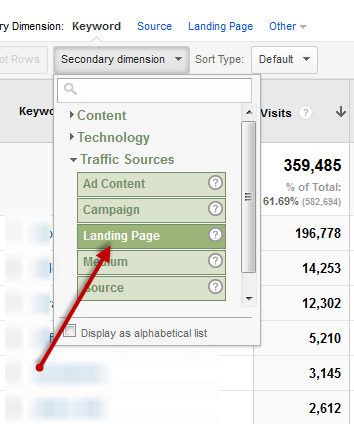 Traffic is great. Traffic that doesn’t convert? Not so great.
Traffic is great. Traffic that doesn’t convert? Not so great.
Don’t get me wrong. I like big traffic numbers just as much as the next guy. In fact, sustained organic traffic growth means what I’m doing is working (for the most part). More people are coming to your site via search engines.
But traffic data doesn’t tell you if those visitors are doing anything of value when they get to your site.
What I really love are conversions. Because conversions, not traffic, pay the bills.
What’s more, proprietary conversion data helps you figure out what is and what isn’t working for an ROI standpoint; where to spend more marketing dollars, where to spend less; which marketing channels are profitable, which aren’t. And that stuff is pretty important. More important that how many visits you’re getting.
This post will outline a six-step process to help you figure out which keywords are driving conversions, and actionable steps to improve the performance of your best and worst performing terms, so you can generate even more conversions.
Step 1: Find Keywords that Convert
This step assumes you have Google Analytics installed on your site and you have goal tracking set up. If you don’t, here are some great tutorials to get you up and running:
There are a few ways to uncover keywords that convert on your site. You can either create a custom report to isolate unique visits and goal completions by keyword. Or you can manually drill down into your traffic sources and isolate goals as they correspond to keywords.

Note: You can find this data in the illustration above by clicking Traffic Sources>Search>Organic and then selecting a Goal Set in Google Analytics.
You then will sort by goal conversion rate to find the highest converting keywords. I like to qualify the data a bit more and include only visits that are “greater than” a specific threshold. This helps filter out the low visit high conversion numbers, which are often misleading.
I typically set advanced filtering for visit thresholds of “greater than” 10, 50, 100, 200 and up, depending on how much traffic the site is generating.

Step 2: Find Corresponding URLs
You also want to determine which pages on your site are driving these keyword conversions. So the next step is to click on “secondary dimension,” and select Traffic Sources>Landing Page from the drop down menu.

You can now export this report to Excel and perform the remainder of your work outside of analytics.
Step 3: Find Out Where Those Keywords Rank
Now that you have your list of the highest converting keywords for your site, you want to determine where they rank.
Again, the goal here is to get these keywords to work even harder for you, which means getting those terms (and the corresponding URLs) to rank higher improve their visibility. So you need to determine current SERP position.
As for rank tracking, my favorite tools are:
Step 4: Create Your Keyword Conversion Report
Once you have keyword rankings, you can pop that info to your spreadsheet along with your list of keywords, corresponding URLs, and conversion rates. Keep visits in the mix as well, since it’s another useful data point, and keyword demand can help you prioritize.

What we typically find during this process are keywords that convert, but aren’t ranking as high as they could be. This presents some really great opportunities because if you can improve SERP visibility for some or all of your top converting keywords, you can exponentially grow conversions.
You can prioritize your efforts in a number of ways as well and determine whether to focus on:
- The highest ranking terms.
- The highest converting terms.
- The highest traffic terms.
For me, I like to scale my efforts and that’s often one way to prioritize, which is why having the corresponding URL is critical. Many times I’ll see multiple high-value keywords tied to the same URL. By focusing on improving the “SEO value” of that URL/page, you can typically increase the rankings of all keywords tied to that URL (i.e., “a rising tide lifts all ships”).
Step 5: Focus on Improving Rankings for Those Keywords
Next steps are to improve the rankings for your highest converting keywords. This means working on both on-site and off-site SEO tactics, which include:
- On-page SEO: Evaluate these pages to ensure they’re as “optimized” as they should be. For example, review title tag structures; keyword placement in headlines, subheads, and body copy, image tagging and see if you can make improvements.
- Beefing up content: We’re seeing a temporal increases in rankings for most if not all keywords that are tied to a URL when content on that page is “freshened up” and improved on (i.e., reworked, rewritten, added to, made more relevant and/or more informative). And in many cases, these temporal rankings stick.
- Internal linking: Grab a list of the most linked to pages on your site. Add anchor text links on those pages back to the pages you’re trying to rank higher, so you can pass pooled link equity and semantic relevance signals to them. Here are more tips on internal linking strategies you can leverage as well. This also serves to move pages higher up in the navigation and fewer clicks from the home page, a nice authority signal.
- Inbound linking: You can prioritize your inbound link building efforts to these target URLs as well. Just don’t overdo it with exact match anchors. Mix in branded links, hybrid variations anchors, citations and trigger words as well to keep it “natural.” I like to review the existing backlink profile of these URLs in ahrefs to get a sense of the existing keyword anchor ratios to inform my anchor text decisions.
- Social signals: Get some shares for these documents (naturally or unnaturally…up to you). Social shares may not be a direct ranking signal (yet…), but good content gets shared and likely can help reinforce popularity and interest-level in a document for engines.
Step 6: Iterate Across Your Site
OK, so you’ve unearthed your highest converting keywords. You’ve mapped those keywords to corresponding URLs. You know where they rank. And you’re working to improve those rankings to grow conversions (and revenue) even more.
The next step, it’s time to leverage that proprietary intelligence that you acquired during this process and apply it to keywords (and corresponding documents) that are underperforming on your site.
To do so, you’re going to:
- Pull a report of your lowest converting keywords (same procedure as finding your highest converting keywords but just sort by lowest goal completions).
- Pull a list of corresponding landing pages.
- Determine where they rank.
Now you want to audit and evaluate each of those pages and the keyword queries that drive traffic to them and see what improvements can be made.
Some factors to compare and contrast and questions to ask in this process are:
Why do these top-performing keywords convert better than others?
- Are they higher intent?
- Are they closer to sale?
- Are they more aligned with the offer on my page?
- Are they longer tail and very specific to the users query vs more general terms?
- Are they product centric (“link building tool” vs “link building”) vs information gathering searches?
What about the corresponding landing page for those keywords? What’s the difference between the top performing landing pages and those that convert poorly? Ask yourself:
- Is it the quality of the content? Is one page better written, more informative, more value-driven than the other pages?
- Is it page structure and format? Is that page laid out better and easier to read and scan?
- Is it the offer? Is it driving to a product download (which is too aggressive) when it should be a free report or newsletter signup?
- Is the topic and the keywords we’re targeting on that page? Are they somehow misaligned with user intent? Are users not finding what they want on a page?
Now apply this knowledge to your pages that don’t convert as well or at all.
Here’s a real world example. A company that sells a cyber security solution published dozens of dedicated pages on the most malicious security threats as part of a keyword strategy. Smart thinking, since if someone is looking for info on a security threat, there’s a good chance they’re trying to prevent it from happening.
And those individual threats pages drove tons of visits. Terrific, right? Not so much.
Turns out the bulk of the traffic came from fledgling hackers, looking for tips or tricks on embedding malicious code (i.e., a lot of searches related to “how to perform”), and not from the consumer audience they were targeting.
Needless to say, a group of keywords that should convert really well for them didn’t drive any conversions at all. So the solution was to rework the content, re-target the pages with better-aligned modifiers, re-focus their phrase-driven link building efforts, develop a better offer that would resonate with consumers, and use clearer SERP descriptions to better qualify clicks, etc.
The results: a marked increase in qualified traffic, leads and conversions.
 Traffic is great. Traffic that doesn’t convert? Not so great.
Traffic is great. Traffic that doesn’t convert? Not so great.


